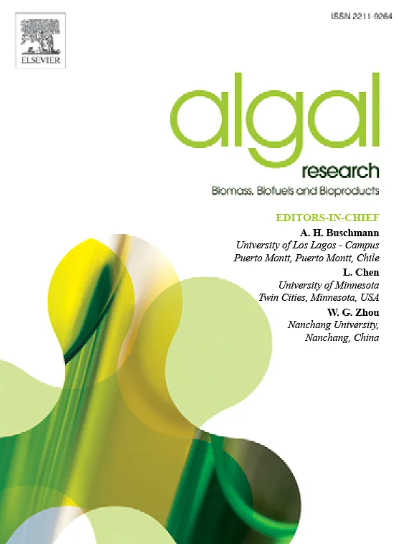通过调节碳氮比和有机碳源,促进异养和混养硫酸Galdieria suluraria的细胞生长和藻蓝蛋白的产生
IF 4.5
2区 生物学
Q1 BIOTECHNOLOGY & APPLIED MICROBIOLOGY
Algal Research-Biomass Biofuels and Bioproducts
Pub Date : 2025-05-08
DOI:10.1016/j.algal.2025.104086
引用次数: 0
摘要
以不同碳氮比的葡萄糖和甘油为碳源,研究了多极微生物Galdieria suluraria CCMEE 5587.1在混合营养和异养条件下代谢产物的生长和积累。结果表明,与葡萄糖(PX = 0.57 ~ 1.38 g L−1 d−1和PPC = 1.4 ~ 31.3 mg L−1 d−1)相比,甘油导致的生物量生产力(PX = 0.32 ~ 0.61 g L−1 d−1)和藻蓝蛋白产量(PPC = 1.7 ~ 20.9 mg L−1 d−1)较低。较低的碳氮比促进了藻胆蛋白的合成,支持了细胞生长。相反,碳氮比的增加导致氮化合物的积累,同时碳水化合物的积累也增加。在考虑培养方式时,混合营养条件下的生物量碳产量显著高于异养条件。这表明细胞从光合作用和呼吸作用中获取能量。在评估的条件中,建议混合营养结合低碳氮比使用葡萄糖生产藻蓝蛋白。本文章由计算机程序翻译,如有差异,请以英文原文为准。

Enhancing cell growth and phycocyanin production in heterotrophic and mixotrophic cultures of Galdieria sulphuraria through modulation of the C/N ratio and organic carbon sources
The growth and accumulation of metabolites in the polyextremophile microalga Galdieria sulphuraria CCMEE 5587.1 were evaluated under mixotrophic and heterotrophic conditions, using glucose and glycerol as carbon sources with varying C/N ratios. The results showed that glycerol resulted in lower biomass productivity (PX = 0.32 to 0.61 g L−1 d−1) and phycocyanin production (PPC = 1.7 to 20.9 mg L−1 d−1) compared to glucose (PX = 0.57 to 1.38 g L−1 d−1 and PPC = 1.4 to 31.3 mg L−1 d−1). A lower C/N ratio enhanced the synthesis of phycobiliproteins and supported cell growth. In contrast, an increase in the C/N ratio led to the accumulation of nitrogen compounds alongside a rise in carbohydrate accumulation. When considering culture mode, biomass yield on carbon was significatively higher in mixotrophic conditions compared to heterotrophic conditions. This indicates that cells derive energy from both photosynthesis and respiration. Among the conditions assessed, mixotrophy combined with a low C/N ratio using glucose is recommended to produce phycocyanin from G. sulphuraria.
求助全文
通过发布文献求助,成功后即可免费获取论文全文。
去求助
来源期刊

Algal Research-Biomass Biofuels and Bioproducts
BIOTECHNOLOGY & APPLIED MICROBIOLOGY-
CiteScore
9.40
自引率
7.80%
发文量
332
期刊介绍:
Algal Research is an international phycology journal covering all areas of emerging technologies in algae biology, biomass production, cultivation, harvesting, extraction, bioproducts, biorefinery, engineering, and econometrics. Algae is defined to include cyanobacteria, microalgae, and protists and symbionts of interest in biotechnology. The journal publishes original research and reviews for the following scope: algal biology, including but not exclusive to: phylogeny, biodiversity, molecular traits, metabolic regulation, and genetic engineering, algal cultivation, e.g. phototrophic systems, heterotrophic systems, and mixotrophic systems, algal harvesting and extraction systems, biotechnology to convert algal biomass and components into biofuels and bioproducts, e.g., nutraceuticals, pharmaceuticals, animal feed, plastics, etc. algal products and their economic assessment
 求助内容:
求助内容: 应助结果提醒方式:
应助结果提醒方式:


